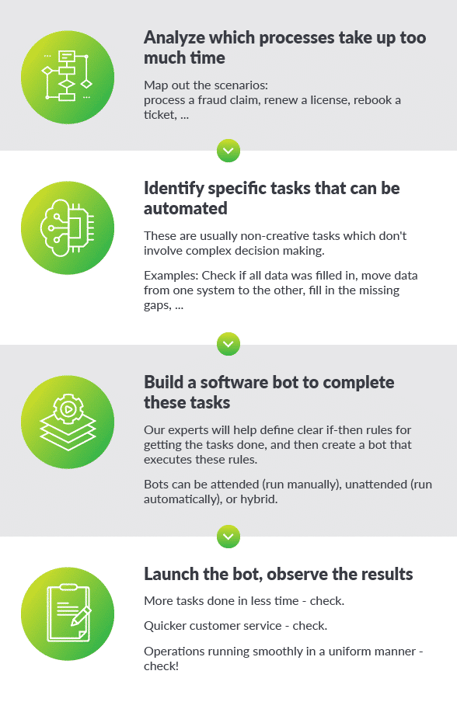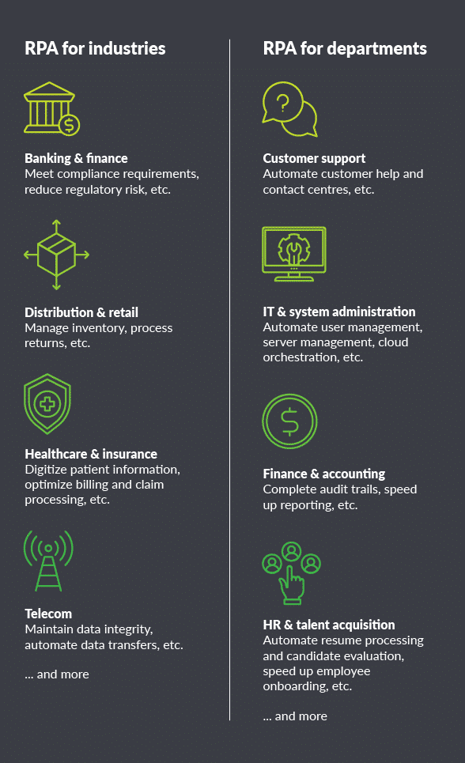RPA for Business: The Perfect Workaround

Robotic process automation (RPA) has its roots in machine learning, natural language processing, and artificial intelligence. This software technology takes the most repetitive tasks out of your hands and leaves you free to do what humans do best – brainstorm, create, solve, and inspire to solve.
Taking the robot out of the human©
© Quote by Professor Leslie Willcox, an expert in technology, work, and globalization at the London School of Economics.
By emulating how humans execute repetitive tasks, RPA can take over these tasks with all the benefits of mechanical execution: tireless, fast, uniform, and error-free.
That way, RPA frees up your employees with their strengths and personal talents for high-value-added activities. Plus, better customer service and faster requests processing.
RPA can take over as many rule-based tasks as you are prepared to hand off, and with time, you’ll find your list growing. It’s not just about individual tasks – RPA can orchestrate entire workflows, from processing retail returns to automatic bank account openings.
RPA Origins & Predictions
The term “robotic process automation” was coined in the early 2000’s and has been growing in popularity ever since. Under the hood, RPA is a cross-cut of several technologies:
- Machine learning & natural language processing. Automatic translation services were first enabled by machine learning which emerged in the 1960’s. It then sparked natural language processing to enable better interpretation of human discourse by machines. Today, machine learning imitates how humans learn, and enables services like recommendation engines and self-piloting cars.
- Screen scraping. Another early technology, screen scraping is used to read data from websites and structure it. For example, it’s at the heart of services that compare prices or weather information.
- Workflow management. Workflow management is all about automating parts of the process, for example, autocompleting package information upon its scanning.
- Artificial intelligence. The purpose of AI is to take over and complete tasks that would usually require human intervention, such as face detection and recognition. Another example is chatbots.
RPA builds on these technologies to automate mundane mechanical tasks and leave humans free to focus on the creative and decision-making parts of their work.
Since it’s a lightweight solution that requires relatively little IT investment, RPA has been predicted to become “the new ERP”. According to an article by McKinsey and Company, its major benefit is “a return on investment that varies between 30 and as much as 200 percent in the first year.”
Why RPA
When it comes to managing various aspects of an organization – order processing, client management, inventories, accounting, document management, employee assessment, strategic planning, etc. – it’s hard (if not impossible) to find a single platform that will rule them all.
Most of us find ourselves juggling many tools that weren’t made to communicate with each other, so we end up mediating the conversation. And while there are tools that automate communication between other tools, they may translate into a long wait and expensive resources.
RPA has the capability to bridge the gaps between technology, people, and business. Here are just a few examples of RPA usage.

Connect disparate apps
Business infrastructure relies on many software tools and legacy systems that may not know how to communicate with each other. Use RPA to define the rules for entering, copying or moving data between these systems. Need to send a list of new claims in an Excel file by email to the management every day at 18:00? The quick answer is RPA.
Make instant changes
Too often, you may find the software lagging behind new business decisions and process changes. RPA was designed to bridge just such gaps. All invoices beyond a set limit now need approval from a board member? Instead of waiting for the feature to get coded into the software, set it up with RPA.
Keep pace with regulations
When new regulations kick in, you need to adapt fast. RPA bots can cross-check and align data in different systems, making sure that all your documentation is compliant and ready for auditing.
The perfect workaround
Whenever your business is facing an urgent change or new circumstances, RPA may become your perfect quick fix, allowing you to adapt on the fly and make a big impact through small changes.
How it Works
RPA provides a custom on-demand communication mechanism, built by your own rules to serve your particular needs.

We partner with UiPath – an industry leader that offers a low-code environment to build and maintain RPA bots. Our team can help set up UiPath and identify the automation-ready tasks and processes to get you started. Going forward, our RPA center of excellence can assist with all RPA-related aspects, from building and maintaining bots to identifying strategic ways for increasing your business value with RPA.
How Do I Know if RPA Is for me
RPA has been successfully implemented in many industries, and more are yet to come. Speaking company-wise, every department has its share of routine tasks that can be automated. Get ahead by freeing your employees for high-value, creative, customer-facing tasks.

Where to Start
Most processes are made up of routine tasks that employees have to complete. Consider how your current processes work. Which tasks are most repetitive and time-consuming? Which stages of the process could do without manual intervention?
Our team of RPA experts can help identify the most “automatable” tasks and provide a proof-of-concept document that will illustrate return on investment.
You can then kick off with a Business Analyst to define a clear set of rules, and a small team of RPA developers to build bots. Once you give the bots a try and measure their impact, you can scale automation to more tasks and processes across your organization, up to the point where 95% of a process are automated, or when key employees have their own high-value bots.
 September 29, 2025
September 29, 2025
Build your team or extend with ours? Here’s what helps fintech CTOs decide
Read the post September 10, 2025
September 10, 2025
Fixed-price projects vs dedicated teams: A fintech CTO comparison
Read the post September 3, 2025
September 3, 2025
How burnout is crippling tech leadership in the Nordics and Benelux
Read the post September 29, 2025
September 29, 2025
Build your team or extend with ours? Here’s what helps fintech CTOs decide
Read the post September 10, 2025
September 10, 2025
Fixed-price projects vs dedicated teams: A fintech CTO comparison
Read the post September 3, 2025
September 3, 2025
How burnout is crippling tech leadership in the Nordics and Benelux
Read the postWrite your own
success story
with Pwrteams!
Share your details in the form, tell us about your needs, and we'll get back with the next steps.
- Build a stable team with a 95.7% retention rate.
- Boost project agility and scalability with quality intact.
- Forget lock-ins, exit fees, or volume commitments.